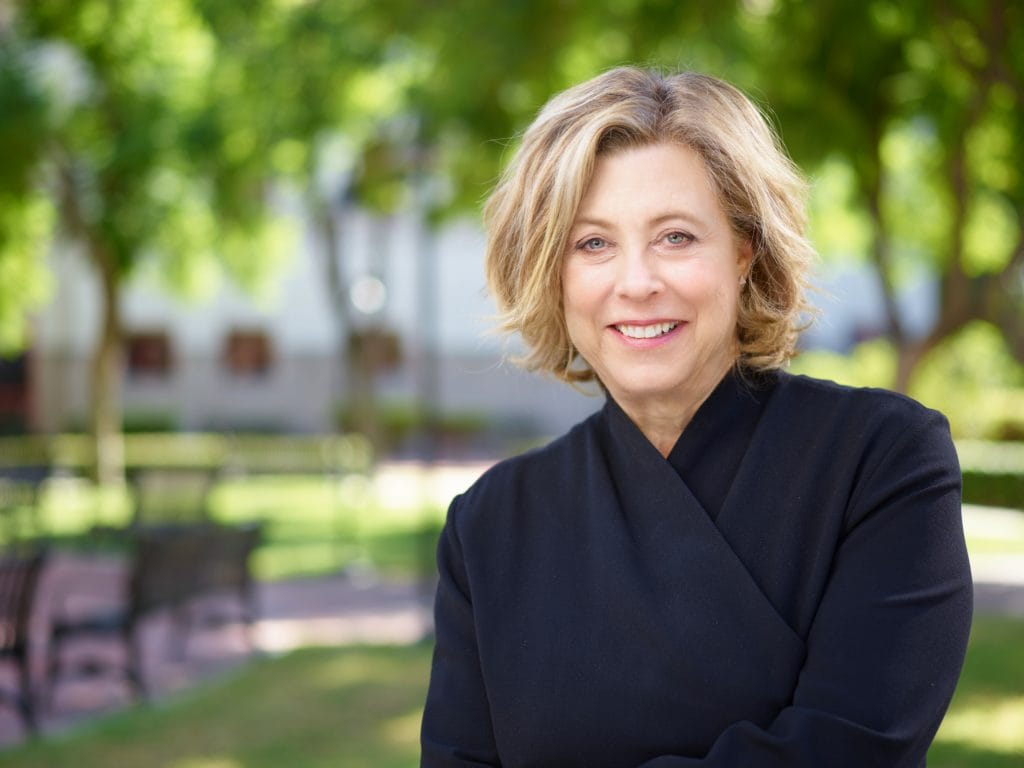Zucker Named Director of the Center for Business & Management of the Arts

The former executive director of L.A.’s county arts commission has deep ties to the center’s programming
A longtime champion of the arts in Southern California and nationally, Laura Zucker has been named as the director of the university’s Center for Business & Management of the Arts (CBMArts),which prepares students for careers in nonprofit and for-profit arts organizations of all disciplines.
Zucker succeeds Jonathan Neil, who served as director of the university’s arts management programs since 2015 and will now continue as Associate Provost for Academic Affairs and Strategic Initiatives at CGU.
Zucker, who is the former executive director of the Los Angeles County Arts Commission (now the Los Angeles County Department of Arts & Culture), brings to her new role what Neil calls an ideal blend of insider and outsider expertise and an established reputation in the Los Angeles arts community.
“Laura is a great pick to lead CBMArts,” Neil said about Zucker’s appointment. “She directed our arts management program for seven years and knows all the players at CGU. And as the Arts Commission’s executive director, she knows all the players in LA’s arts sector, too. She’s an exceptional educator and will serve CBMArts students, faculty, and alumni very well.”
CGU’s arts business and management program was still in its infancy when Zucker first agreed in 2008 to direct—and teach in—the program while serving as the LA County Arts Commission executive director.
“I’ve always believed in this program,” she said, “and I’ve been invested in it from the beginning. It’s really an honor now to come back and lead it.”
Leading in the Creative Capital of the World
Los Angeles is one of just three U.S. cities (the others are New York City and San Francisco) that are considered “arts super cities,” with very high concentrations of artists relative to the rest of the population. Artists and art organizations, Zucker says, are an integral part of L.A.’s economic engine, and that is why “arts education is so critically needed now.”
For her, CBMArts is ideally positioned both geographically and in its academic programming to respond to that need.
“A significant motivation for many of the students who choose CGU’s arts management programs is the fact that we are located in the creative capital of the world,” she explains. “What they find here are opportunities to concretely innovate in the field and have a significant impact on cultural life, not only in our region, but across the world.”
That word “impact” also aptly describes Zucker’s career in the creative industries, including her 25-year tenure with the L.A. County Arts Commission, during which she created and oversaw the civic art policy for the county and directed the funding for more than 400 arts organizations.
As busy as she was in that county role, Zucker says she always sought to maintain ties with CGU and keep involved as an educator in its arts management programs because—as is true of many of CBMArts’ faculty members—it has enabled her to bring academic theory together with her real-world experiences.
“What I’ve loved about being involved with CGU’s programs is that it’s always helped me balance practice with theory,” she says. “Being involved with CBMArts has provided a space for me, and our other faculty members, to think deeply about issues we’re facing in the field. That in turn gives our students a clearer understanding of the kinds of issues they might confront one day in their own careers—or already are.”
Restoring and Integrating the Arts
During her tenure with the county, Zucker says she discovered her “inner policy wonk” and experienced a deep excitement in having the ability to produce changes on the macro level.
“Having an ability to affect a huge arts ecology like Los Angeles through legislative initiatives and programs that lift all of the boats was both challenging and exhilarating for me,” she explains.
Zucker’s county work included implementing a regional initiative to restore arts education to all 81 of the county’s public school districts (though Zucker says that restoration is just the tip of the iceberg and more work remains) as well as creating a strategic plan for Cultural Equity and Inclusion that produced 13 actionable recommendations (with the County Board of Supervisors adopting seven of these so far). She also led an $80-million revitalization of the Ford Theatres, as well as creating the largest paid internship program in the arts in the country for undergraduates through a public-private partnership with the Getty Trust.
Zucker is especially proud of the arts internship program, which today employs more than 275 graduates every summer for ten weeks in good-paying positions with nonprofit organizations that enable them to build networks and pursue careers in arts management.
“I have always called paid internships the secret sauce of the arts engine in LA.,” she says. “There was no place for the undergraduate students in the arts internship program to go on to graduate work before the program with CGU started, and we were losing them to other parts of the country. Today, CBMArts has become an important pipeline for these undergraduates to pursue mission-driven careers.”

Zucker also notes the commission’s work under her leadership on the creation of a civic arts program for Los Angeles that integrates art into all county capital projects and has been a way, she says, of “democratizing arts and culture in the county.” This program utilizes one percent of the cost of public construction projects—ranging from $10,000 to $1 million—and uses it to include works of art in all disciplines in these projects.
“It’s been a way to transform how the county thinks about its public spaces,” she says. “We don’t just want art locked up in buildings where some people won’t have access to it. This effort was made to integrate art through all public spaces, whether a renovated park or a new library or an animal control center or a hospital, and has made art what I believe it should be, like breathing—something that is always there, around us.”
From Actor to Advocate
Scratch the surface of any arts administrator, Zucker says, and you’ll find an artist. It was true for her. In the early 1970s, Zucker felt an inner calling to be an actor and attended the Yale School of Drama.
But what changed her career trajectory were two words: Meryl Streep.

Streep was one of Zucker’s classmates at Yale, and “it was clear to me,” she says, “that she was wildly more talented than I was and was being cast in all the plum roles I wanted. That’s what got me thinking that I should be directing instead”—until the department’s head told her women couldn’t be directors.
Frustrated, Zucker left Yale to pursue a directing career, which in turn led her to producing and managing a theater. Her experiences gave her an epiphany about the many opportunities open to artists in the creative industries.
“It’s only after working as an artist that you begin to realize there are myriad other interesting career options,” she says. “Many artists discover that it can be just as creative to serve in a leadership role and enable other artists to do what they do. I realized it’s all a matter of scale, whether I was running a theater and helping produce artists’ works, or working for Los Angeles County, where the scale increased in ways I never could have imagined. It’s all been enormously gratifying.”
The disappointment she experienced at Yale over pursuing a directing career has given Zucker a sympathy and sensitivity to the discrimination that can take place in the arts industry. One of the last large initiatives she led with the commission was the Cultural Equity and Inclusion Initiative mentioned earlier.
“Although I don’t have the lived experience many have had in not having access to opportunities in arts and culture, as a young woman I experienced gender disparity directly,” she says. “I think that’s one of the most important things our program at CBMArts addresses. We have an incredibly diverse student body and faculty, and the future of arts and culture in our country and the world is going to be about the acceptance and cross fertilization and valuing of all cultural traditions.”
The Power of CBMArts Alumni
One of the new efforts now under way to increase the visibility of CBMArts and highlight its value proposition is a special series of alumni panels starting this summer and continuing next year. For Zucker, these panel events will highlight the program’s many outstanding graduates—there are some 320 members in the CBMArts alumni community—who have moved into substantial roles in their professions.
“When I started with the program, it was nascent and we had no alumni to speak of,” she says, “but now one of the joys I have is seeing all the amazing places where our alumni are working now.”
Six panels have been planned that will enable alumni to address current and prospective students about the organizations where they work and their career paths.
“People don’t really realize all the possible career paths, so I think these panels over the course of the year will help everyone see the possibilities of what can be done with this degree,” Zucker says.

The first of these events, “The Art of Giving,” is coming at noon PDT on July 20, and will feature alumni Gerlie Collado (Panta Rhea Foundation), Inés Familiar Miller (Kresge Foundation), Lauren Nichols (Anthony and Jeanne Pritzker Family Foundation), and Lisa Woon (Edison International) in conversation with Zucker.
Interested? There is still time to register here for the event.
Reflecting on her long association with arts management at CGU, Zucker says she takes deep personal satisfaction in these alumni events and listening to the achievements of the program’s graduates.
“No matter how my role changed, almost everybody has been my student. I’ve taught for almost every year since the program’s inception. It’s so fantastic to be part of something long enough to see the students blossom in their careers.”